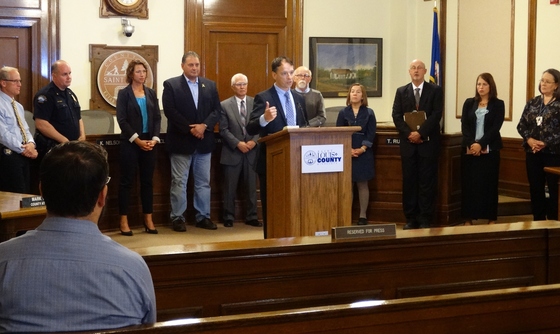NEWS RELEASE
FOR IMMEDIATE RELEASE:
September 6, 2017
CONTACT: Linnea Mirsch, Public Health & Human Services Director
218-726-2096
Minnesota awards St. Louis County $675,000 for rapid expansion of treatment and recovery resources for people experiencing opioid use disorder
As the heroin epidemic continues nationwide, the shortage of treatment options and the delays this can cause have been a frustrating – and sometimes deadly – barrier for people battling addiction and their loved ones.
St. Louis County has been working for several years, building partnerships to combat this regional epidemic on multiple fronts. These efforts, it was announced today, have been recognized with a $675,000 grant from the Minnesota State Targeted Response to the Opioid Crisis which will fund, three new or expanded treatment and prevention options in St. Louis County to help people overcome this dangerous addiction.
St. Louis County worked with regional partners in applying for the grant, which specifically focused on increasing access to treatment, reducing unmet treatment need, and reducing opioid overdose related deaths through prevention, treatment and recovery activities. The funding has been awarded for the following:
- $525,000 for two programs to be administered by the Center for Alcohol and Drug Treatment (CADT). These include $300,000 to develop a six bed opioid withdrawal unit, and $225,000 for expanded office based opioid treatment and medication assisted treatment.
- $94,318 to the Rural AIDS Action Network (RAAN) for expanded naloxone (Narcan) treatment
- $39,682 to the University of Minnesota, Duluth School of Pharmacy for expanded naloxone treatment
“We are lucky to have such qualified partners in our county, and I am optimistic that we will see lives changed and saved as a result of the grant and these new programs,” said St. Louis County Commissioner Patrick Boyle. “This grant sought to rapidly expand treatment and recovery resources for people with opioid use disorder, and because of the strong partners we have and the relationships already in place, we were able to quickly propose programs that will make a critical difference.”
The grant will provide funding for 21 months. Meanwhile,
the St. Louis County Board has authorized up to $450,000 in funding for the opioid withdrawal unit for this year and next. Additionally, the Substance Abuse and Mental Health Services Administration (SAMHSA) has awarded $435,000 - through a grant to the Sixth Judicial District - which also will help fund costs of CADT's opioid withdrawal unit.
Within days, CADT will begin accepting referrals to the new withdrawal unit, which is located in its facility at 1402 East Superior Street in Duluth. It will provide initial detoxification services for people battling opioid addiction, based on referrals from the county, as well as other providers and detoxification facilities throughout the county and region. The expected stay is three to five days, after which the person would move on to the next phase of treatment.
"The opioid withdrawal management unit will eliminate major obstacles to access medically supervised care in a safe environment, provide diagnostic assessment, and make direct referrals to longer-term and life-saving treatment options," said Gary Olson, CADT executive director. "Along with our existing ClearPath Clinic and a grant-supported outpatient Suboxone clinic, CADT along with other regional treatment providers and community partners, can offer a pathway to recovery to anyone ready and willing to escape the vicious and dangerous cycle of opioid addiction."
Meanwhile, the office based opioid treatment and medication assisted treatment will involve a physician monitoring and tapering medications for a patient seeking to break their addiction.
St. Louis County is the only successful grantee in Minnesota receiving funds for expanding naloxone treatment. The funding will cover outreach to pharmacies, specifically rural pharmacies, and provide education and training on naloxone with the goal of increasing dispensing by 50 percent. RAAN will also expand outreach efforts in specific, under-served communities, for harm reduction strategies including naloxone training and distribution, clean syringes, HIV and Hepatitis C testing. This portion of the grant also will fund outreach and naloxone training for families of drug court participants in St. Louis and Carlton counties and at institutions of higher education to prevent opioid overdose. Further reaching, UMD School of Pharmacy and RAAN will be working in collaboration with existing area coalitions throughout St. Louis and Carlton counties to build local infrastructures composed of key community members, tribal professionals, medical professionals, public health and social service professionals to strive to reduce opioid overdose in their community.
The $675,000 in funding is part of the total $5.4 million awarded to the State of Minnesota through the 21st Centuries Cures Act approved by Congress last December. St. Louis County is responsible for administering the grant.
 St. Louis County and area partners announce they've received a $675,000 grant to help people battling opioid addiction. St. Louis Commissioner Patrick Boyle is shown surrounded by L-R: Sheriff Ross Litman; Duluth Police Chief Mike Tusken; Duluth Mayor Emily Larson; Commissioner Mike Jugovich; Auditor Don Dicklich; Gary Olson, Center for Alcohol and Drug Treatment Executive Director; Ida Rukavina, liaision for Sen. Amy Klobuchar; Greg Anderson, Social Services Supervisor for St. Louis County; Laura Palombi, UMD College of Pharmacy; and Maggie Kazel, Rural Aids Action Network
###
|